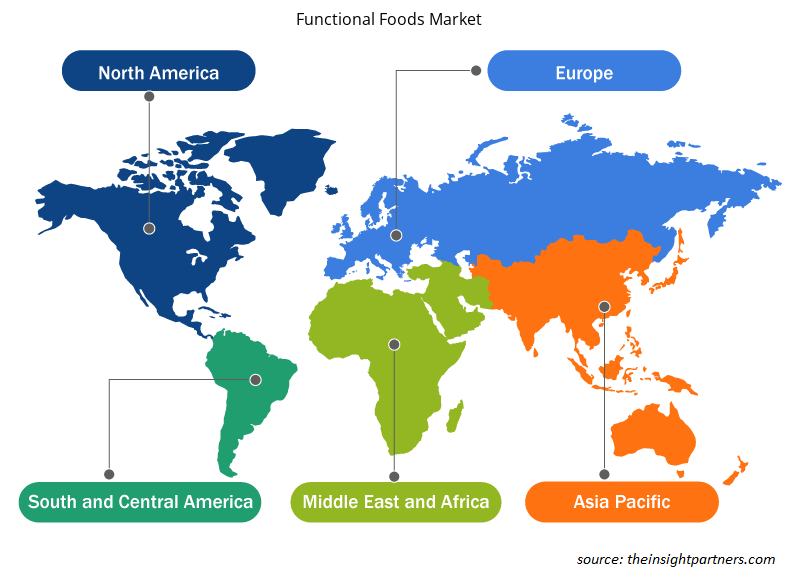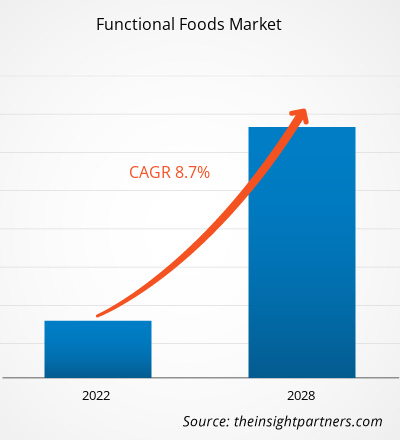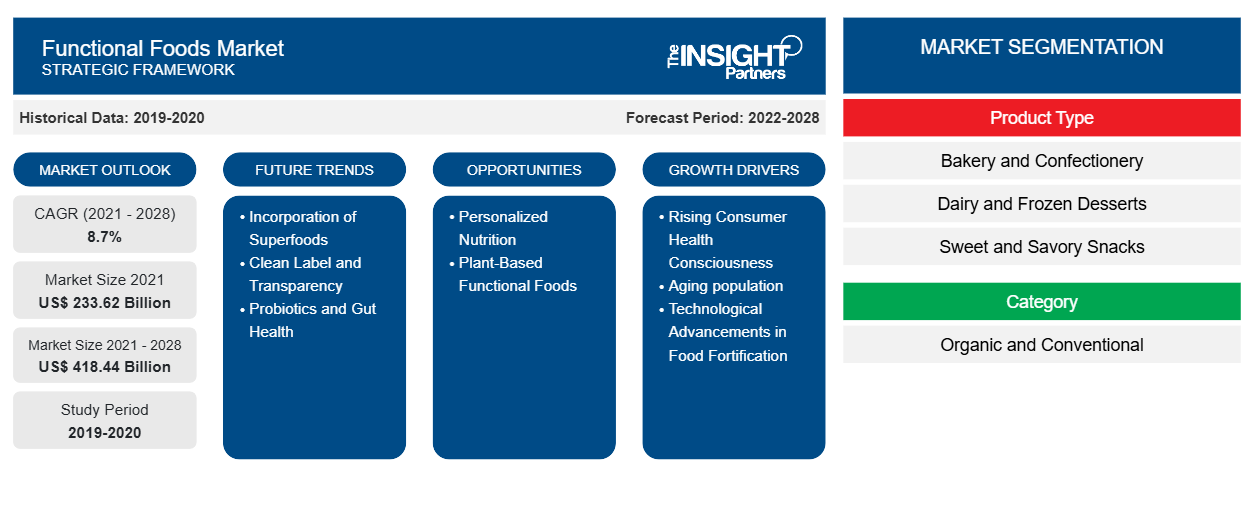Il mercato degli alimenti funzionali è stato valutato a 233.620,18 milioni di dollari nel 2021 e si prevede che raggiungerà i 418.439,42 milioni di dollari entro il 2028. Si prevede che crescerà a un CAGR dell'8,7% dal 2021 al 2028.
Gli alimenti funzionali sono alimenti integrali, fortificati, arricchiti o migliorati che forniscono benefici per la salute e nutrienti essenziali (ad esempio vitamine e minerali) se consumati regolarmente in quantità adeguate come parte di una dieta varia. Gli alimenti funzionali hanno benefici unici per la salute che vanno oltre il tipico apporto giornaliero di nutrienti, come una maggiore salute delle ossa, la gestione del colesterolo e una migliore salute del cuore. Inoltre, si prevede che l'espansione del mercato degli alimenti funzionali sarà guidata dalla crescente domanda di additivi alimentari nutrienti e fortificanti . I produttori di alimenti stanno fortificando i loro prodotti con aggiunte salutari come acidi grassi omega-3, fibre, vitamine e minerali. L'obiettivo di aggiungere gli additivi sopra menzionati nell'industria alimentare è quello di aumentare il valore nutrizionale degli alimenti.
L'Asia Pacifica ha detenuto la quota maggiore del mercato globale degli alimenti funzionali nel 2020 e si prevede che l'Asia Pacifica crescerà in modo significativo nel periodo di previsione. Un aumento dell'interesse dei consumatori e una migliore comprensione delle proprietà di rafforzamento dell'immunità di una dieta e di abitudini alimentari appropriate sono tra i principali fattori trainanti che alimentano l'espansione degli alimenti funzionali nella regione. Inoltre, l'assunzione di fast food sta causando cambiamenti dannosi nelle condizioni di salute e aumentando l'incidenza di malattie croniche come diabete e obesità. I consumatori stanno spendendo più soldi in alimenti nutrizionali per migliorare la loro salute generale man mano che diventano più consapevoli di questi problemi di salute, aumentando la crescita del mercato degli alimenti funzionali della regione.
Personalizza questo report in base alle tue esigenze
Riceverai la personalizzazione gratuita di qualsiasi report, comprese parti di questo report, o analisi a livello nazionale, pacchetto dati Excel, oltre a usufruire di grandi offerte e sconti per start-up e università
-
Scopri le principali tendenze di mercato in questo rapporto.Questo campione GRATUITO includerà analisi di dati che spaziano dalle tendenze di mercato alle stime e alle previsioni.
Impatto della pandemia di COVID-19 sul mercato degli alimenti funzionali
La pandemia di COVID-19 ha colpito molti settori a causa di lockdown a livello nazionale, chiusure aziendali e interruzioni della catena di fornitura. La pandemia ha avuto un impatto misto sul mercato degli alimenti funzionali. Inizialmente, a causa di lockdown e chiusure aziendali, i produttori hanno sofferto di una carenza di materie prime e manodopera, che ha influenzato la loro produzione e fornitura. Tuttavia, man mano che le persone sono diventate più attente alla salute, hanno preferito prodotti che migliorassero la salute. Gli alimenti funzionali hanno registrato una domanda significativa in quanto aiutano a migliorare la salute delle ossa, a gestire i livelli di colesterolo e la salute del cuore. Inoltre, la domanda di alimenti funzionali o fortificati si è espansa in molte regioni grazie al marketing positivo e intenso delle aziende e alle raccomandazioni di specialisti della salute come medici, nutrizionisti e altri. Ad esempio, secondo il Functional Food & Beverage 2020 Report dell'Hartman Group, basato sulla ricerca di aprile, il 31% dei consumatori sta assumendo più integratori e il 29% sta consumando più alimenti/bevande funzionali a causa della pandemia. Inoltre, molte nazioni sono vaccinate e i governi hanno allentato le restrizioni imposte alla produzione e al commercio. Pertanto, la pandemia di COVID-19 ha avuto un impatto significativo sul mercato degli alimenti funzionali.
Approfondimenti di mercato
Crescente domanda di spuntini salutari
A causa dei recenti cambiamenti nel comportamento dei consumatori, il mercato mondiale degli snack si sta spostando dagli snack piccanti e oleosi verso varianti più sane, senza zucchero, ricche di nutrienti e povere di olio confezionate in piccole quantità. Ciò sta stimolando la crescita del mercato degli alimenti funzionali, poiché questi alimenti sono in genere ricchi di nutrienti importanti, tra cui vitamine, minerali, grassi sani e fibre. I consumatori della New Age cercano opzioni di snack nutrienti, da asporto e convenienti che soddisfino le loro esigenze nutrizionali quotidiane e che soddisfino al contempo le loro papille gustative. Ad esempio, secondo un recente sondaggio di Mondelez, oltre il 59% degli adulti in tutto il mondo preferisce consumare più piccoli pasti durante il giorno piuttosto che pochi pasti più grandi. I consumatori sono sempre più interessati agli snack funzionali per energia, concentrazione e relax, in particolare sotto forma di barrette e alimenti sostitutivi dei pasti. Inoltre, incorporare una premiscela di nutrienti personalizzata in uno snack è una strategia efficace per incorporare nutrienti benefici come acidi grassi omega-3, vitamine e minerali. Gli snack funzionali non solo riempiono lo stomaco, ma forniscono anche una cura più duratura alla fame. Questi ingredienti forniscono i mattoni di cui il corpo ha bisogno mentre mangia cibi ricchi di nutrienti. Di conseguenza, le persone non saranno così affamate durante il giorno. Si prevede che questo fattore fornirà diverse tendenze chiave che avranno un impatto sul mercato globale degli alimenti funzionali nei prossimi anni.
Approfondimenti sulla categoria
In base alla categoria, il mercato degli alimenti funzionali è segmentato in biologico e convenzionale. Il segmento convenzionale deteneva una quota di mercato maggiore. Si prevede che il segmento biologico crescerà a un CAGR più rapido durante il periodo di previsione. La crescente domanda dei consumatori di alimenti funzionali biologici ha motivato le aziende e i coltivatori a promuovere l'agricoltura biologica, che sta guidando il segmento. I produttori stanno sviluppando alimenti funzionali biologici per soddisfare la crescente domanda dei consumatori. Ad esempio, Nature's Path Foods, un produttore statunitense di cereali per la colazione biologici certificati confezionati, ha registrato una crescita stellare per i suoi cereali per la colazione Organic Optimum Power. Pertanto, la crescente domanda di alimenti biologici dovuta all'aumento della consapevolezza della salute, nonché alla consapevolezza degli effetti nocivi dei pesticidi, sta guidando il segmento degli alimenti funzionali biologici.
Informazioni sul tipo di prodotto
In base al tipo di prodotto, il mercato degli alimenti funzionali è suddiviso in prodotti da forno e dolciumi, latticini e dessert surgelati , snack dolci e salati, cereali per la colazione e altri. Si prevede che il segmento dei latticini e dei dessert surgelati detenga la quota di mercato maggiore nel mercato globale degli alimenti funzionali nel periodo di previsione. I prodotti lattiero-caseari fermentati forniscono benefici per la salute e stanno ampliando la gamma di prodotti lattiero-caseari funzionali. Insieme a questo, i benefici nutrizionali forniti dal latte svolgono un ruolo significativo nel controllo delle malattie croniche. Il latte fortificato contiene vari nutrienti ed è una buona fonte di vitamina A e D e aiuta a prevenire l'anemia sideropenica nei bambini. Aiuta anche a migliorare la salute delle ossa poiché il latte fortificato è una buona fonte di calcio, fosforo e vitamina D. Il dessert surgelato è fondamentalmente un dessert ottenuto congelando liquidi, semisolidi e talvolta solidi. I dessert surgelati funzionali forniscono benefici per la salute ai consumatori poiché includono vari ingredienti funzionali come prebiotici e probiotici. Pertanto, i benefici per la salute offerti dai dessert surgelati funzionali stanno alimentando la crescita del segmento nel mercato globale degli alimenti funzionali.
Informazioni sui canali di distribuzione
In base al canale di distribuzione, il mercato degli alimenti funzionali è suddiviso in supermercati e ipermercati, minimarket, vendita al dettaglio online e altri. Il segmento dei supermercati e degli ipermercati ha rappresentato la quota di mercato maggiore nel mercato degli alimenti funzionali nel 2020, mentre si prevede che il segmento della vendita al dettaglio online sarà il segmento in più rapida crescita durante il periodo di previsione. Il boom dell'e-commerce ha effettivamente fornito significative opportunità alle vendite al dettaglio online di prodotti alimentari funzionali. Dopo l'inizio della pandemia, i principali produttori stanno accedendo più attivamente alle popolari piattaforme di e-commerce con un mix di prezzi allettanti, vendite e supporto solidi e un'esperienza di acquisto migliorata per i consumatori. Si prevede che questo aspetto aiuterà le piattaforme online a diventare uno dei canali di distribuzione in più rapida crescita a livello globale. Questi fattori stanno guidando il segmento del canale di vendita al dettaglio online del mercato degli alimenti funzionali.
I principali attori che operano nel mercato degli alimenti funzionali includono Unilever; Clif Bar & Company.; Laird Superfood; Abbott; Danone SA; GENERAL MILLS, INC.; HILDUR; Nestlé; Kellogg Company; e Good Source Foods, LLC. Questi attori sono impegnati nello sviluppo di prodotti innovativi per soddisfare le tendenze emergenti dei consumatori. Inoltre, sono coinvolti in fusioni e acquisizioni, espansione aziendale e partnership per espandere la loro quota di mercato a livello globale.
Cibo funzionale
Approfondimenti regionali sul mercato degli alimenti funzionali
Le tendenze regionali e i fattori che influenzano il mercato degli alimenti funzionali durante il periodo di previsione sono stati ampiamente spiegati dagli analisti di Insight Partners. Questa sezione discute anche i segmenti e la geografia del mercato degli alimenti funzionali in Nord America, Europa, Asia Pacifico, Medio Oriente e Africa e America centrale e meridionale.

- Ottieni i dati specifici regionali per il mercato degli alimenti funzionali
Ambito del rapporto sul mercato degli alimenti funzionali
| Attributo del report | Dettagli |
|---|---|
| Dimensioni del mercato nel 2021 | 233,62 miliardi di dollari USA |
| Dimensioni del mercato entro il 2028 | 418,44 miliardi di dollari USA |
| CAGR globale (2021 - 2028) | 8,7% |
| Dati storici | 2019-2020 |
| Periodo di previsione | 2022-2028 |
| Segmenti coperti |
Per tipo di prodotto
|
| Regioni e Paesi coperti |
America del Nord
|
| Leader di mercato e profili aziendali chiave |
|
Densità degli attori del mercato degli alimenti funzionali: comprendere il suo impatto sulle dinamiche aziendali
Il mercato dei Functional Foods Market sta crescendo rapidamente, spinto dalla crescente domanda degli utenti finali dovuta a fattori quali l'evoluzione delle preferenze dei consumatori, i progressi tecnologici e una maggiore consapevolezza dei benefici del prodotto. Con l'aumento della domanda, le aziende stanno ampliando le loro offerte, innovando per soddisfare le esigenze dei consumatori e capitalizzando sulle tendenze emergenti, il che alimenta ulteriormente la crescita del mercato.
La densità degli operatori di mercato si riferisce alla distribuzione di aziende o società che operano in un particolare mercato o settore. Indica quanti concorrenti (operatori di mercato) sono presenti in un dato spazio di mercato in relazione alle sue dimensioni o al valore di mercato totale.
Le principali aziende che operano nel mercato degli alimenti funzionali sono:
- LABORATORI ABBOTT
- CLIF BAR E SOCIETÀ
- DANONE SA
- MULINI GENERALI, INC.
- BUONA FONTE DI ALIMENTI, LLC
Disclaimer : le aziende elencate sopra non sono classificate secondo un ordine particolare.

- Ottieni una panoramica dei principali attori del mercato degli alimenti funzionali
Segnala i riflettori
- Tendenze industriali progressive nel mercato degli alimenti funzionali per aiutare gli operatori a sviluppare strategie efficaci a lungo termine
- Strategie di crescita aziendale adottate dai mercati sviluppati e in via di sviluppo
- Analisi quantitativa del mercato degli alimenti funzionali dal 2019 al 2028
- Stima della domanda globale di alimenti funzionali
- Analisi delle cinque forze di Porter per illustrare l'efficacia degli acquirenti e dei fornitori che operano nel settore
- Sviluppi recenti per comprendere lo scenario competitivo del mercato
- Tendenze e prospettive di mercato, nonché fattori che guidano e frenano la crescita del mercato degli alimenti funzionali
- Assistenza nel processo decisionale evidenziando le strategie di mercato che sostengono l'interesse commerciale, portando alla crescita del mercato
- La dimensione del mercato degli alimenti funzionali in vari nodi
- Panoramica dettagliata e segmentazione del mercato, nonché dinamiche del settore degli alimenti funzionali
- Dimensioni del mercato degli alimenti funzionali in diverse regioni con promettenti opportunità di crescita
- Analisi storica (2 anni), anno base, previsione (7 anni) con CAGR
- Analisi PEST e SWOT
- Valore/volume delle dimensioni del mercato - Globale, Regionale, Nazionale
- Industria e panorama competitivo
- Set di dati Excel
Report recenti
Testimonianze
Motivo dell'acquisto
- Processo decisionale informato
- Comprensione delle dinamiche di mercato
- Analisi competitiva
- Analisi dei clienti
- Previsioni di mercato
- Mitigazione del rischio
- Pianificazione strategica
- Giustificazione degli investimenti
- Identificazione dei mercati emergenti
- Miglioramento delle strategie di marketing
- Aumento dell'efficienza operativa
- Allineamento alle tendenze normative























 Ottieni un campione gratuito per - Mercato degli alimenti funzionali
Ottieni un campione gratuito per - Mercato degli alimenti funzionali